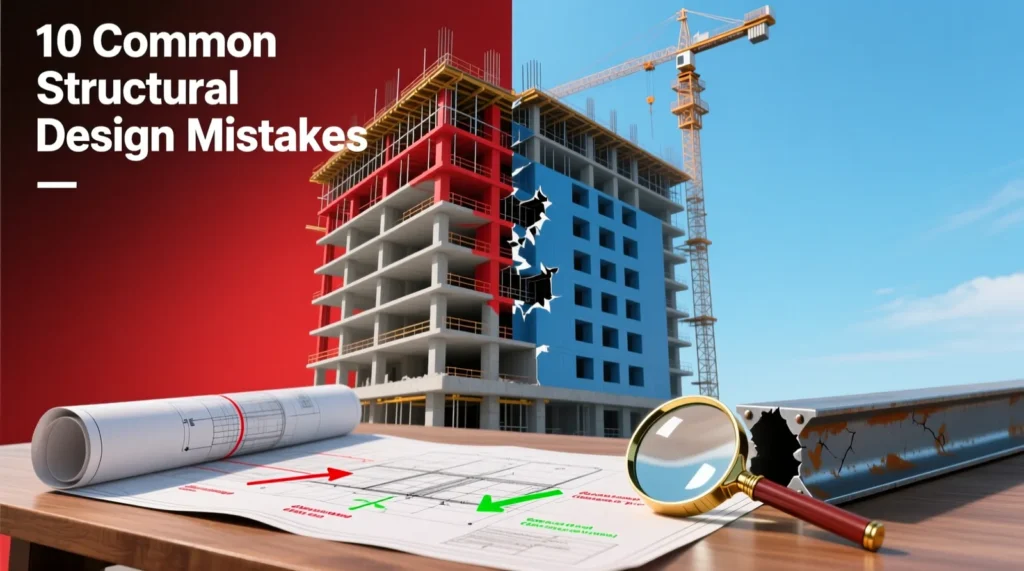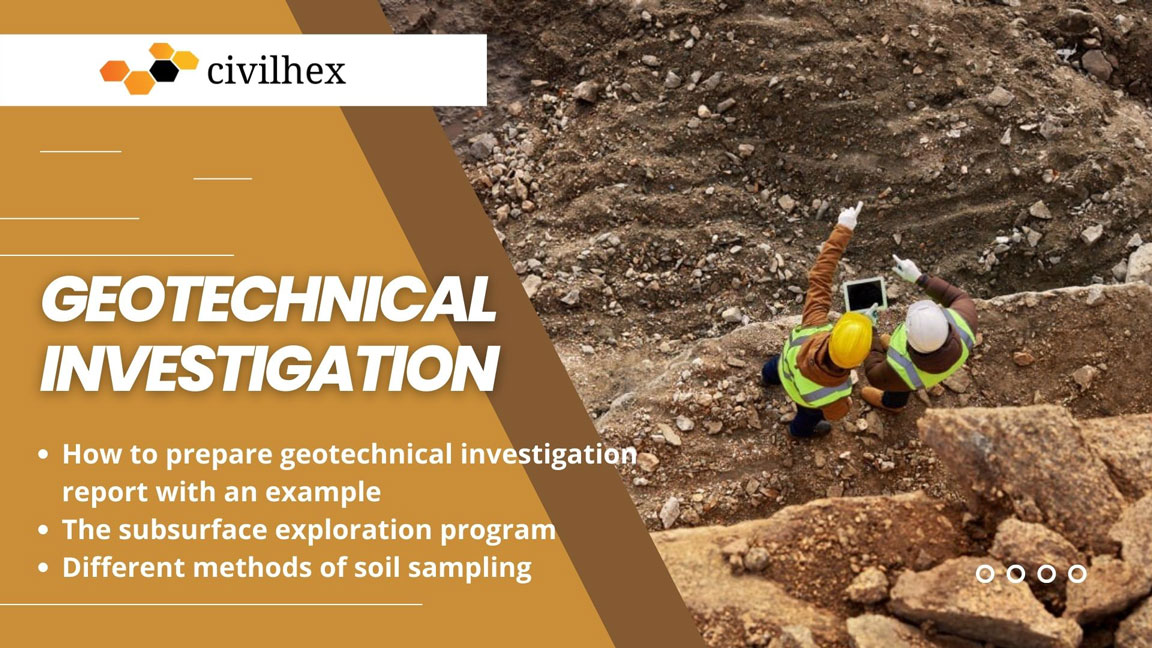10 Common Structural Design Mistakes and How to Avoid Them

- Introduction
- 1. Inaccurate Load Estimation
- 2. Inadequate Geotechnical Investigation
- 3. Poor Reinforcement Detailing
- 4. Oversimplified Structural Modeling
- 5. Ignoring Construction Tolerances & Buildability
- 6. Neglecting Connection Design (Steel & Composite)
- 7. Using Outdated Codes or Ignoring Local Amendments
- 8. Lack of Interdisciplinary Coordination
- 9. Weak QA/QC and Peer-Review Process
- 10. Missing As-Built Documentation & Maintenance Planning
- 🧠 Real-World Example: Flat-Slab Punching Shear Failure
- 🧩 Expert Tips for Safer Structural Design
- 🏁 Conclusion
- 📚 References
Introduction
Structural design is the foundation of safe and durable construction. Yet even experienced civil engineers sometimes make critical mistakes that compromise strength, safety, or cost-efficiency.
In this article, we’ll uncover the 10 most common structural design mistakes, why they occur, and practical strategies to prevent them. Whether you’re a structural engineer, architect, or project manager, mastering these principles helps you ensure building safety, compliance, and performance on every project.
1. Inaccurate Load Estimation
The Problem:
Designers often underestimate live loads, wind loads, or temporary construction loads, leading to overstressed members or excessive deflection.
Consequences:
- Overloaded beams and slabs
- Excessive vibration or cracking
- Safety hazards under extreme events
How to Avoid It:
- Use up-to-date building codes for all load combinations.
- Include special loads such as equipment, storage, and crane operations.
- Conduct sensitivity analyses by varying loads ±20 %.
- Cross-check with peer review or past project data.
💡 Tip: Create a “load assumption sheet” for every project and get it signed off before final design.
2. Inadequate Geotechnical Investigation
The Problem:
Skipping or underestimating a soil test means the foundation is designed on assumptions rather than data.
Consequences:
- Uneven settlement
- Foundation cracking
- Tilt or structural failure
How to Avoid It:
- Conduct detailed geotechnical investigations (SPT/CPT, boreholes, lab testing).
- Account for groundwater conditions and soil variability.
- Select the right foundation type — shallow, raft, or pile — based on soil results.
- Monitor settlement during and after construction.
| Foundation Type | Suitable Soil | Key Advantage |
|---|---|---|
| Shallow Footing | Dense Sand / Hard Clay | Economical and easy to build |
| Raft Foundation | Medium Clay / Variable Soil | Reduces differential settlement |
| Pile Foundation | Soft / Weak Soil | Transfers load to deeper stable strata |
3. Poor Reinforcement Detailing
The Problem:
Reinforcement detailing errors — wrong lap lengths, missing stirrups, or poor anchorage — are among the most frequent causes of failure in RC structures.
Consequences:
- Cracks and corrosion
- Punching shear failure
- Reduced ductility during earthquakes
How to Avoid It:
- Follow code-specific detailing rules for lap, cover, and development length.
- Check shop drawings for bar congestion and anchorage.
- Ensure site supervision verifies bar placement before concreting.
4. Oversimplified Structural Modeling
The Problem:
Simplifying a structure too much can lead to missing key load paths or ignoring second-order (P-Δ) effects.
Consequences:
- Incorrect member forces
- Unpredicted deflection or instability
- Unsafe load redistribution
How to Avoid It:
- Use validated finite element models (FEM) for complex geometry.
- Apply nonlinear analysis where appropriate.
- Check software results using hand calculations for sanity.
| Modeling Level | Use Case | Accuracy | Effort |
|---|---|---|---|
| Hand Calculations | Simple Beams | Medium | Low |
| 2D Frame Analysis | Regular Frames | High | Moderate |
| 3D FEM Model | Irregular Structures | Very High | High |
5. Ignoring Construction Tolerances & Buildability
The Problem:
Designing with zero tolerance or unrealistic accuracy creates site conflicts during construction.
Consequences:
- Misaligned columns or beams
- Field modifications that reduce strength
- Costly rework
How to Avoid It:
- Include tolerance limits in drawings (e.g., rebar ±10 mm, formwork ±15 mm).
- Coordinate early with contractors for constructability review.
- Simplify congested reinforcement zones.
6. Neglecting Connection Design (Steel & Composite)
The Problem:
Connections are often left for fabricators to “figure out,” even though they govern structural safety.
Consequences:
- Bolt or weld failures
- Unexpected joint rotation
- Progressive collapse
How to Avoid It:
- Perform detailed connection calculations.
- Design for fatigue where cyclic loads exist (e.g., cranes).
- Review fabrication drawings to verify geometry and weld access.
7. Using Outdated Codes or Ignoring Local Amendments
The Problem:
Designing with an old code version or missing local amendments can make your design non-compliant or unsafe.
Consequences:
- Failing building-permit review
- Non-conformance with modern safety factors
- Seismic or wind under-design
How to Avoid It:
- Record the edition and year of every code used.
- Cross-check local building authority updates.
- Periodically review new releases from standards organizations.
8. Lack of Interdisciplinary Coordination
The Problem:
Structural elements often clash with MEP services, ducts, or architectural layouts if not coordinated.
Consequences:
- Reinforcement cuts for openings
- Unexpected stress concentrations
- Time-consuming redesigns
How to Avoid It:
- Use BIM coordination to detect clashes early.
- Hold weekly interdisciplinary reviews during design.
- Freeze openings and penetrations before detailed analysis.
| Coordination Stage | Main Output | Participants |
|---|---|---|
| Concept Design | Load paths, grids | Architect + Structural |
| Detailed Design | Penetrations, member sizing | Structural + MEP |
| Pre-construction | Shop drawings, tolerances | Contractor + Fabricator |
9. Weak QA/QC and Peer-Review Process
The Problem:
Skipping design review or documentation checks allows calculation errors and drafting mistakes to pass unnoticed.
Consequences:
- Design errors reaching site
- Material waste or under-strength sections
- Project delays and disputes
How to Avoid It:
- Implement QA/QC checklists for every deliverable.
- Use independent peer-review for critical structures.
- Maintain version control of drawings and models.
- Audit field construction to confirm compliance.
10. Missing As-Built Documentation & Maintenance Planning
The Problem:
Many teams stop documentation once construction is complete. Without accurate as-built data, future modifications become risky.
Consequences:
- Unsafe retrofits
- Overloading of structural members
- Difficulty verifying capacity
How to Avoid It:
- Require record drawings at handover.
- Update BIM models with field dimensions.
- Develop a maintenance plan outlining inspection frequency and structural monitoring.
🧠 Real-World Example: Flat-Slab Punching Shear Failure

A parking structure suffered localized collapse after a car lift was installed. Investigation revealed missing shear reinforcement and poor detailing near column capitals. The slab was designed using a generic template without site-specific load checks.
Key Takeaways:
- Always verify punching shear capacity in flat slabs.
- Review load paths around columns and openings.
- Inspect reinforcement before concrete placement.
🧩 Expert Tips for Safer Structural Design
- Create a Risk Register – List top design and construction risks for every project.
- Validate Geotech Early – Foundation design is only as good as the soil report.
- Design for Robustness – Favor redundancy and ductility over minimal compliance.
- Mandate Peer Review – Independent checks reduce liability and prevent oversight.
- Maintain Documentation – Record code versions, design assumptions, and inspection logs.
🏁 Conclusion
Avoiding these 10 structural design mistakes is not about perfection — it’s about proactive risk control.
By applying these principles, engineers can design stronger, safer, and longer-lasting structures that meet both code and client expectations.
Whether you’re designing a small residence or a high-rise building, your greatest tool remains engineering judgment backed by good data.
📚 References
- EasyEngineering – “5 Common Structural Design Errors and How to Avoid Them”
- CSA Engineering – “Common Structural Design Mistakes and How to Avoid Them”
- StruCalc Blog – “Top 8 Design and Code Mistakes for Structural Engineers”
- Westatix – “5 Common Mistakes in Structural Design”
- ResearchGate – “Structural Failure of Buildings: Issues and Challenges”





Responses